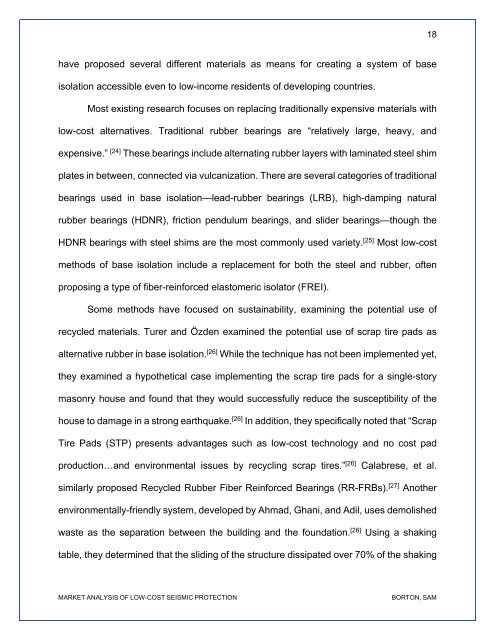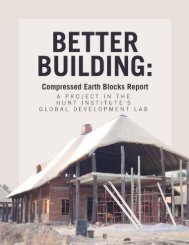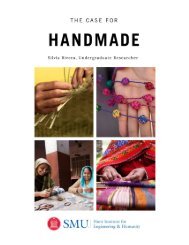Seeking Low-Cost Seismic Protection for Urban Masonry in an Unstable Terrain
Earthquakes pose a significant threat to housing in developing countries. The citizens of these countries often lack the financial means to sufficiently protect their homes against seismic actions. In accordance with the eleventh UN Sustainable Development Goal (SDG), steps need to be taken to protect these vulnerable populations from the looming possibility of a severe earthquake. Specifically, the geographic location of Peru designates it as an especially earthquake-prone country, and many of its citizens cannot afford seismic reinforcement for their homes. Middle-class, urban residents, such as those in Lima, Peru often reside in informally constructed confined masonry houses which, in the case of a severe earthquake, would likely suffer significant damage or even collapse. For this reason, the seismic protection market is increasingly narrowing its focus to low-cost solutions. This report summarizes the existing low-cost propositions and discusses to what extent they would provide a feasible option for the aforementioned target population in Peru. Finding that even these “low-cost” solutions are out of reach for most of the middle-class residents of Lima, this report makes an alternate proposition. Rocking isolation offers great potential as an innovative and economical seismic protection alternative, but it has yet to be implemented as low-cost housing reinforcement. This emerging system of seismic protection could fill a gap in the market as it may provide a sufficiently low-cost accessible manner of protecting confined masonry homes.
Earthquakes pose a significant threat to housing in developing countries. The citizens of these countries often lack the financial means to sufficiently protect their homes against seismic actions. In accordance with the eleventh UN Sustainable Development Goal (SDG), steps need to be taken to protect these vulnerable populations from the looming possibility of a severe earthquake. Specifically, the geographic location of Peru designates it as an especially earthquake-prone country, and many of its citizens cannot afford seismic reinforcement for their homes. Middle-class, urban residents, such as those in Lima, Peru often reside in informally constructed confined masonry houses which, in the case of a severe earthquake, would likely suffer significant damage or even collapse. For this reason, the seismic protection market is increasingly narrowing its focus to low-cost solutions.
This report summarizes the existing low-cost propositions and discusses to what extent they would provide a feasible option for the aforementioned target population in Peru. Finding that even these “low-cost” solutions are out of reach for most of the middle-class residents of Lima, this report makes an alternate proposition. Rocking isolation offers great potential as an innovative and economical seismic protection alternative, but it has yet to be implemented as low-cost housing reinforcement. This emerging system of seismic protection could fill a gap in the market as it may provide a sufficiently low-cost accessible manner of protecting confined masonry homes.
Create successful ePaper yourself
Turn your PDF publications into a flip-book with our unique Google optimized e-Paper software.
18<br />
have proposed several different materials as me<strong>an</strong>s <strong>for</strong> creat<strong>in</strong>g a system of base<br />
isolation accessible even to low-<strong>in</strong>come residents of develop<strong>in</strong>g countries.<br />
Most exist<strong>in</strong>g research focuses on replac<strong>in</strong>g traditionally expensive materials with<br />
low-cost alternatives. Traditional rubber bear<strong>in</strong>gs are “relatively large, heavy, <strong>an</strong>d<br />
expensive.” [24] These bear<strong>in</strong>gs <strong>in</strong>clude alternat<strong>in</strong>g rubber layers with lam<strong>in</strong>ated steel shim<br />
plates <strong>in</strong> between, connected via vulc<strong>an</strong>ization. There are several categories of traditional<br />
bear<strong>in</strong>gs used <strong>in</strong> base isolation—lead-rubber bear<strong>in</strong>gs (LRB), high-damp<strong>in</strong>g natural<br />
rubber bear<strong>in</strong>gs (HDNR), friction pendulum bear<strong>in</strong>gs, <strong>an</strong>d slider bear<strong>in</strong>gs—though the<br />
HDNR bear<strong>in</strong>gs with steel shims are the most commonly used variety. [25] Most low-cost<br />
methods of base isolation <strong>in</strong>clude a replacement <strong>for</strong> both the steel <strong>an</strong>d rubber, often<br />
propos<strong>in</strong>g a type of fiber-re<strong>in</strong><strong>for</strong>ced elastomeric isolator (FREI).<br />
Some methods have focused on susta<strong>in</strong>ability, exam<strong>in</strong><strong>in</strong>g the potential use of<br />
recycled materials. Turer <strong>an</strong>d Özden exam<strong>in</strong>ed the potential use of scrap tire pads as<br />
alternative rubber <strong>in</strong> base isolation. [26] While the technique has not been implemented yet,<br />
they exam<strong>in</strong>ed a hypothetical case implement<strong>in</strong>g the scrap tire pads <strong>for</strong> a s<strong>in</strong>gle-story<br />
masonry house <strong>an</strong>d found that they would successfully reduce the susceptibility of the<br />
house to damage <strong>in</strong> a strong earthquake. [26] In addition, they specifically noted that “Scrap<br />
Tire Pads (STP) presents adv<strong>an</strong>tages such as low-cost technology <strong>an</strong>d no cost pad<br />
production…<strong>an</strong>d environmental issues by recycl<strong>in</strong>g scrap tires.” [26] Calabrese, et al.<br />
similarly proposed Recycled Rubber Fiber Re<strong>in</strong><strong>for</strong>ced Bear<strong>in</strong>gs (RR-FRBs). [27] Another<br />
environmentally-friendly system, developed by Ahmad, Gh<strong>an</strong>i, <strong>an</strong>d Adil, uses demolished<br />
waste as the separation between the build<strong>in</strong>g <strong>an</strong>d the foundation. [28] Us<strong>in</strong>g a shak<strong>in</strong>g<br />
table, they determ<strong>in</strong>ed that the slid<strong>in</strong>g of the structure dissipated over 70% of the shak<strong>in</strong>g<br />
MARKET ANALYSIS OF LOW-COST SEISMIC PROTECTION<br />
BORTON, SAM













